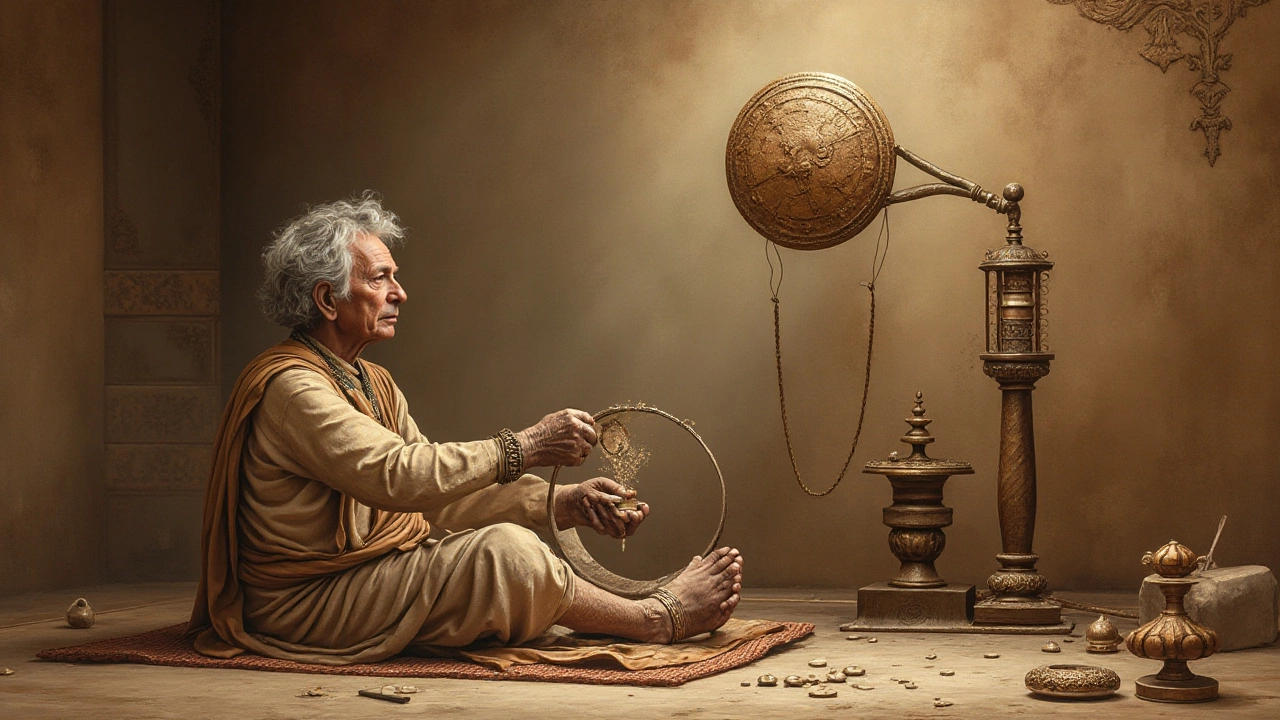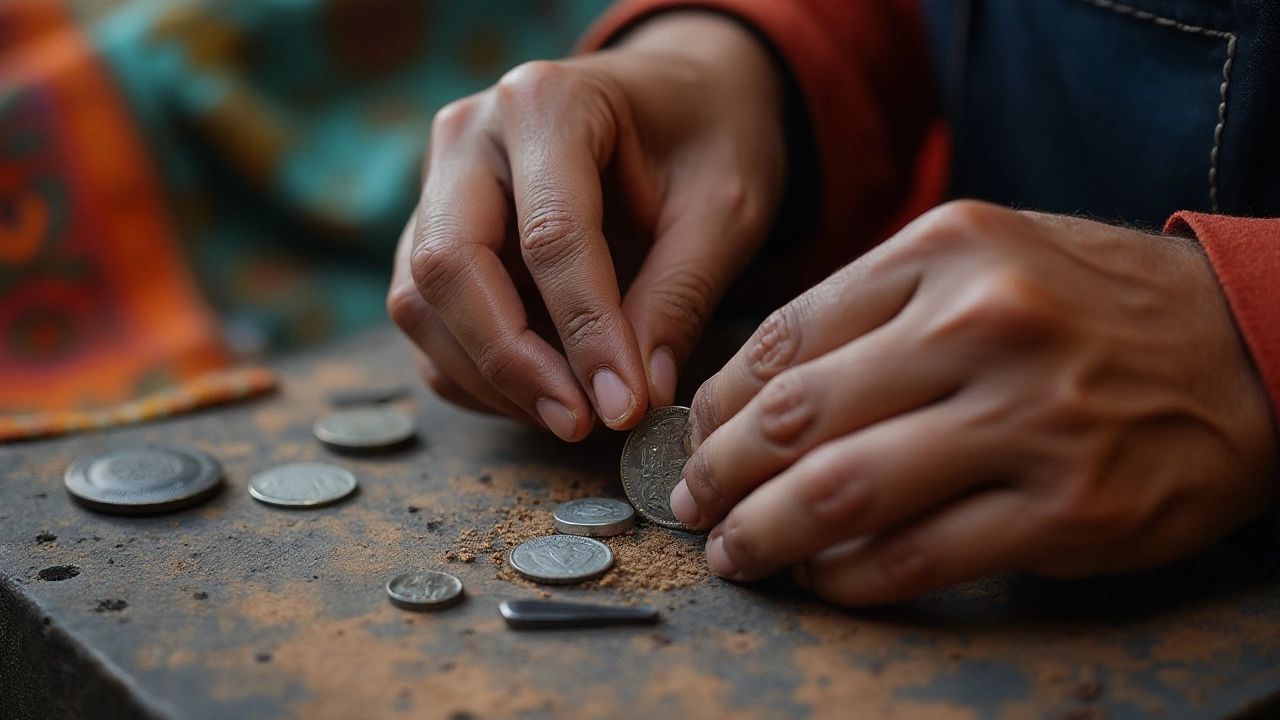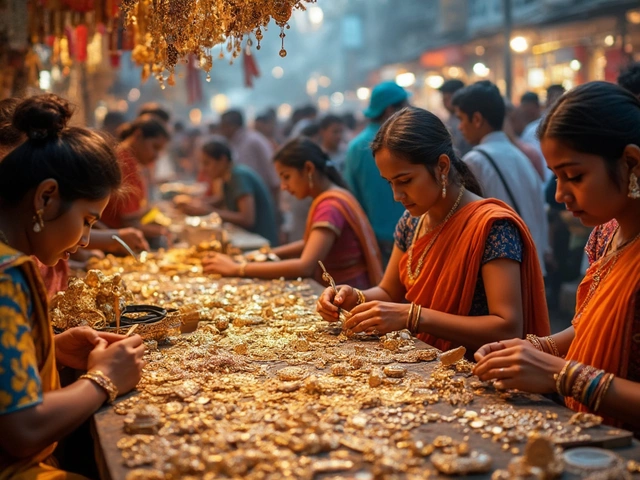In the realm of crafting, transforming a simple quarter into a beautiful ring is a practice that marries creativity with skill. This artistic endeavor not only breathes new life into ordinary coins but also leads to visually stunning and personalized jewelry pieces. Yet, while the craft itself is fascinating, it raises important questions regarding legality and ethical practices.
Altering currency might sound like a gray area, but it is essential to understand the laws that govern such modifications. These regulations ensure that while we indulge in creative expressions, we do so within the boundaries set by authorities. As we delve deeper into this topic, we will explore the techniques used by artisans, the tools essential for the craft, and the historical roots that have influenced contemporary practices. If you're intrigued by the notion of turning simple coins into wearable art, this article is a resourceful guide to get you started while keeping legal concerns in check.
- The Art of Coin Crafting
- Legal Implications of Altering Currency
- Popular Techniques in Coin Ring Making
- Selecting the Right Tools for the Job
- Historical Context of Coin Modification
- Crafting Coins: Tips and Inspiration
The Art of Coin Crafting
Coin crafting is a fascinating process where everyday currency is creatively transformed into unique pieces of art. The practice of making a ring from a quarter encapsulates this artistry, offering a perfect blend of historical significance and modern aesthetics. The craft not only highlights an artisan's skill but also symbolizes a unique connection to the past, as each coin carries its own story. These coins, circulated for years and worn down by the touch of countless hands, become personal artifacts once they are crafted into jewelry. The transformation from mundane to magnificent requires not only a keen eye for design but also a steady hand to execute the process.
Using a quarter as the base material offers several advantages. The metal is light but durable and has enough malleability to allow detailed crafting without breaking. As one embarks on this creative endeavor, selecting the right coin is crucial. Collectors and artisans often seek out quarters with unique marks or historical significance, like those minted in specific years or carrying particular symbols. The crafting journey begins by assessing the best quarters for the design, considering both the final aesthetic of the ring and the story the coin might tell.
The process of crafting a coin ring is a labor of love that involves multiple stages, each demanding precision and patience. It begins with annealing the coin over a flame, a step that slightly softens the metal, making it easier to work with. Then comes the delicate task of creating a hole at the coin’s center, a job that must be done carefully to preserve the band’s width and ensure uniformity. After this, the coin is hammered along the edges, coaxing it into a perfect circular band through methods honed over time. The artisan’s tools, from mandrels to dapping blocks, play an integral role in shaping the metal. A well-organized workspace, stocked with the right equipment, transforms the challenging task into a rhythmic and almost meditative process.
Among enthusiasts, the appeal of turning a plain coin into a sophisticated piece of jewelry lies in more than just the end product. It's in the act of giving new life to currency that might have gone unappreciated. Time and again, artisans have highlighted their love for the craft. In the words of an esteemed craftsman,
"Turning a quarter into a ring allows us to hold history in our hands, shaping it into something beautiful and enduring."Such statements underline the emotional connection between the creator and the creation, a bond that endows each finished piece with a rich tapestry of personal significance.
Legal Implications of Altering Currency
Turning a quarter into a ring might seem like a harmless, creative endeavor. However, it's important to be aware of the legal guidelines surrounding the alteration of currency. In the United States, the chief law that concerns this activity is Title 18, Section 331 of the U.S. Code. This part of the legislation stipulates that it is illegal to fraudulently alter, deface, mutilate, impair, diminish, falsify, or lighten coins. The focus here is on fraudulent intent—meaning the law is primarily interested in preventing tampering aimed at counterfeit practices. If your intention is purely artistic or novelty, you're typically in the clear.
It's significant to note that while altering a coin without fraudulent intent is generally considered legal, selling altered currency where the original coin's value is misrepresented can potentially pose legal challenges. For instance, misleading people into buying rings under the premise that they hold a special monetary worth related to the original coin—that's where the legal boundaries start to blur. This point of legality can be nuanced, prompting many artisans to ensure transparency in their crafting ventures. Importantly, it's always wise to check the specific laws that apply in your region if you're considering making or selling quarter ring jewelry, as laws can vary between jurisdictions. The same can apply to state or privately minted coins which may have separate guidelines.
Alex Herrera, a noted craft law advisor, once said,
"While the law may allow for artistic transformation, always ensure your sales narrative is as honest as your craftsmanship."This serves as a reminder that while you explore the art of creating jewelry making from currency, honesty should guide your creation and marketing practices. The precautionary approach can protect you from running afoul of laws while ensuring that the artistic spirit in jewelry making thrives without legal hindrance.
Beyond legal terminology, there's also an intriguing societal perspective to consider. Throughout history, currency has not just existed as monetary units, but also as cultural symbols. In some cultures, transforming currency into artistic objects can be seen as a way to commemorate significant events or express individuality. The fascination isn't just with the metal but what it represents. Thus, when a crafter takes to coin crafting, they are often engaging in a dialog between the history of the coin and its future as a unique piece of art. This cultural dimension often adds to the allure of making rings and other objects from coins, enveloping the craft in a tapestry of legal, cultural, and historical narratives.

Popular Techniques in Coin Ring Making
Creating a quarter ring has become a captivating craft for many, blending technical skill with artistic flair. The techniques involved have evolved over the years, influenced by both traditional metalworking and modern innovations. One of the foundational methods is known as the 'hammering technique.' This approach involves methodically heating the coin and gently hammering its edges to form a smooth band. Through this consistent process, the coin gradually transforms into a ring shape. A critical aspect here is maintaining even pressure to prevent the coin from losing its symmetry. Patience is the key, as taking too many shortcuts can result in a misshapen ring, far from the desired elegant form.
The 'spinning technique' is another popular method, often favored by those who appreciate a more mechanical approach. Here, crafters employ a lathe or drill press to gradually adjust the coin’s shape. As the coin spins at high speed, careful use of a mandrel helps in shaping it into a uniform band. This technique requires precision, as manipulating speed and pressure impacts the final outcome significantly. Some artisans prefer using a spoon to nudge the coin’s edges consistently during the spinning process, adding a touch of manual finesse to the artwork. It's fascinating to watch how methodically this is done, considering how each coin has its own character and level of pliability.
Coin crafting is about making the right impressions, quite literally. The 'stamping technique' is also quite notable, especially among creators who want their pieces to retain the intricate designs of the original coin. By placing a die over the coin and applying pressure, artists can often preserve the embossed details on the inner or outer band of their rings. This method is particularly beloved by those who treasure the history and uniqueness stamped on each coin. The process allows for a more personalized touch, resulting in a ring that tells a silent story about its origins, aligning art with preservation.
"Crafting a ring from a coin requires more than mere technique; it demands an understanding of the material’s nature and the patience to let it speak," says renowned metal artist John C. Kaufman, reflecting on the delicate balance between skill and intuition. The magic of this craft lies in its blend of tactile experience and creative exploration, where every tool used, from hammers to mandrels, is an extension of the artisan's hands and vision.
Additionally, the process can also involve chemical techniques, particularly for those interested in coloring or texturing. A solution of liver of sulfur, for instance, can patina the surface, giving the jewelry piece a weathered, antique look with tones varying from grey to blue to black. These techniques offer crafters the opportunity to infuse additional layers of creativity into their work, turning each ring into a unique canvas.
| Technique | Tools Required | Finish |
|---|---|---|
| Hammering | Hammer, heat source, mandrel | Smooth, rounded |
| Spinning | Lathe, drill press, mandrel | Uniform, symmetrical |
| Stamping | Die, press, hammer | Detailed emboss |
Each technique carries its own charm and challenges, and mastering them involves more than just technical prowess. It demands a sensitivity towards the material—an acknowledgment of the coin’s past life as a mere currency and its rebirth as a cherished piece of art. Exploring these methods lets creators delve into a world where history and craftsmanship intertwine, offering endless possibilities for personal expression and artistry in coin crafting.
Selecting the Right Tools for the Job
Embarking on the journey of crafting a ring from a quarter begins with choosing the correct tools. This process requires more than simple creativity; it demands precision, patience, and the aid of a comprehensive toolset designed for coin crafting. At the basics, you'll need a ring mandrel, a sturdy hammer, and a coin punch. A coin punch helps in forming the initial hole in the coin, setting the stage for the rest of your crafting. Meanwhile, a ring mandrel serves as an invaluable aid in shaping and sizing the ring, offering a progressive scale of sizes that ensure your ring fits perfectly on the desired finger.
The hammer, which might seem like a primitive tool, is crucial for gently shaping the coin over the mandrel. Accuracy is key here, and the use of a rawhide mallet can minimize unwanted markings or flattening. An experienced ring maker often emphasizes the need for sandpaper of varying grits, polishing cloths, and a metal file. These will refine and smoothen out the ring's surface, creating a finished look that's both aesthetically pleasing and comfortable to wear.
As noted by the Craft Jewelers Collective, "The transformation of a coin into a wearable piece of art is as much about the artist's eye as it is the tools in their hand."
Additional tools such as rotary polishing wheels or Dremel tools can further enhance the surface finishing. Those engaged in more advanced crafting may also opt for metal patinas to add color variations or unique finishes to the ring's surface. Whether you're a hobbyist or aiming for a professional touch, every tool plays a specialized role in ensuring the final product is not just visually appealing but also embodies personal expression. Here's a brief look at a fundamental quarter ring toolset:
- Coin Punch: Initiates the hole in the quarter.
- Ring Mandrel: Aids in shaping and sizing.
- Rawhide Mallet: Prevents unwanted markings.
- Sandpaper and Polishing Cloths: Refine surface smoothness.
- Rotary Tools: Enhance finishing touches and detailing.
It may seem like a lot at first, but learning which tools work best for your style and how to use them effectively will significantly improve the crafting process. Remember, while the end goal is a beautifully crafted ring, the journey there is equally rewarding. Whether it's the excitement of watching a quarter transform or simply enjoying the tactile experience, the tools serve as a bridge between your vision and reality. And always be sure to handle all tools safely, particularly when using sharp or heavy items, to protect yourself along the way.

Historical Context of Coin Modification
The transformation of coins into decorative items dates back centuries, when the creative impulse to embellish or repurpose currency first emerged. Throughout history, coins have served not only as a medium of exchange but have also been adapted into works of art, cultural symbols, and even status markers. One of the earliest forms of coin modification was the practice of turning coins into love tokens, which became particularly popular during the Victorian era. Young men would sand down the faces of coins to smooth blank slates, etching affectionate messages and imagery onto them as sentimental gifts. Coin crafting in this form highlighted an intersection of economic tool and emotional expression.
Exploration into coin modification finds its roots in both necessity and culture. During times of economic strife or coin shortages, communities would adapt existing coins as a means to continue trade and barter efficiently. This led to the creation of 'holey dollars,' where coins were stamped or reshaped to signify a new value or ownership in areas like early Australia. The holey dollar system, although born out of need, inadvertently paved the way for artistry in coin crafting. By the mid-20th century, with the rise of subcultures, there was a revival in appreciating coins beyond their face value. Penny smashing, notably seen at fairs, served as both entertainment and keepsake production, inspiring a generation to think of coins as something more than currency.
Echoing through history, the alteration of coins often mirrors the societies they hail from. The ancient Greeks and Romans would skillfully engrave coins with intricate designs, reflecting religious themes and political dynasties. Their mindfulness in craftsmanship allows today's historians to gain insight into past civilizations' artistry and prominence. In medieval times, coin clipping became a notorious practice. While technically illegal due to its association with reducing valuable metal content, it speaks to the ingenuity and desperation apparent in those eras. Coin crafting, including legitimate uses, grew into an art of deduction and fascination. As we fast forward, the notion of creating rings from quarters is a testament to the ingenuity inherent in turning mundane objects into forms of self-expression. Today, many artisans and jewelers are rediscovering and reinvigorating these age-old techniques.
The modern-day craft showcases a symbiosis of historical knowledge and personal flair. As enthusiasts delve into creating quarter rings, they often draw inspiration from the methods and motives of those who practiced centuries before. The continuous evolution of coin art illustrates both technological advances and shifts in cultural perception, which many find both intriguing and reassuring. As arts and crafts movements continue to sweep across the globe, embellishing coins retains its allure, forever inscribed in the pages of history.
"Coins possess a unique connection to our past, and when we create art from these delicate disks, we forge a tangible link to a shared human experience." - Nomi M. Stolzenberg
Whether fashioning keepsakes or designing intricate jewelry, recognizing the historical context of coin modifications deepens appreciation for a craft that transcends mere monetary value, inviting creators to engage in a dance with time. Coins tell stories, and crafting them into new forms amplifies these tales, allowing each piece to carry with it the weight of epochs, mixed with individual expression.
Crafting Coins: Tips and Inspiration
Making a quarter ring isn't just about transforming metal; it's about marrying tradition with modern creativity. This craft resonates deeply with those who appreciate handmade jewelry, combining age-old techniques with contemporary design. One of the first things you need to consider is the type of coin you wish to transform. While quarters are a popular choice due to their size and material, other coins can also work remarkably well. The most critical tip to remember is to select coins that hold personal meaning, an idea echoed by many artisans. This enriches your crafting process with stories, imbuing each piece with sentimentality.
The method you choose to shape your coin can significantly impact the final product. Whether you're aiming for a polished look or a more rustic charm, there's a variety of techniques at your disposal. For those just starting, 'folding' is one of the simplest methods requiring minimal tools. Alternatively, experienced artisans can attempt techniques like 'centering the punch' for a more refined finish. When executing your design, patience is paramount. Rushing the process can cause unwanted fractures or inconsistencies. Taking your time to shape each piece ensures precision and care, honing a beautifully crafted ring in the end.
"The art of turning coins into jewelry is as much about the narrative as it is about the craft. Each coin carries a story from the past, waiting to be retold." — Joseph Baer, Master Jeweler
In keeping with the essence of jewelry making, investing in quality tools can make a noteworthy difference. Commonly used tools include doming blocks, mandrels, and hammers, all of which shape the ring to your preference. Investing in a comfort-fit ring sizer ensures the final piece isn’t just beautiful, but also wearable. Be critical of your tools, as higher quality often leads to smoother finishes and fewer mishaps. One rewarding aspect of this craft is that with time and practice, artisans often evolve their own set of preferred techniques and tools that work best for them.
A key point of inspiration for many comes from the historical significance of coins. During ancient times, coins were often fashioned into wearable objects, believed to bring prosperity or protection. Understanding this historical context not only deepens appreciation but can spark creativity in how you conceptualize your designs. Dive into history and consider how these past narratives might influence your creative direction. Perhaps a coin ring inspired by historical motifs could be your next project idea!
If you’re lookIng for fresh inspiration, consider the themes based on seasons, birthdays, or even personal milestones. Artistic communities online often engage in challenges that create monthly themes for crafting new pieces. This can be a great way to spark creativity and keep ideas flowing. To summarize some insights on various crafting communities:
| Community | Focus | Features |
|---|---|---|
| Craftsy.com | General crafting and jewelry | Periodic themes and tutorials |
| The Coin Crafter's Guild | Coin to jewelry conversion | History discussions and tool advice |
| Pinterest Boards | Artisan inspiration | Vast visual resources |
Ultimately, crafting from coins is not just about creating jewelry; it's a process of creating stories. Every ring reflects both a personal and historical tale, captured in precious metal. With proper knowledge, quality tools, inspiration, and a touch of patience, anyone can master this fascinating craft. As you embark on this creative journey, remember to honor both the material and the narrative you are about to shape with your own hands.



